El Gorg Blau (The Blue Pool) was a beauty spot in the Tramuntana mountain range in Majorca, one of the highest and wildest points on the island. There, after passing through a deep narrow gorge, a mountain stream drained into a small lake before continuing on its way to the sea.
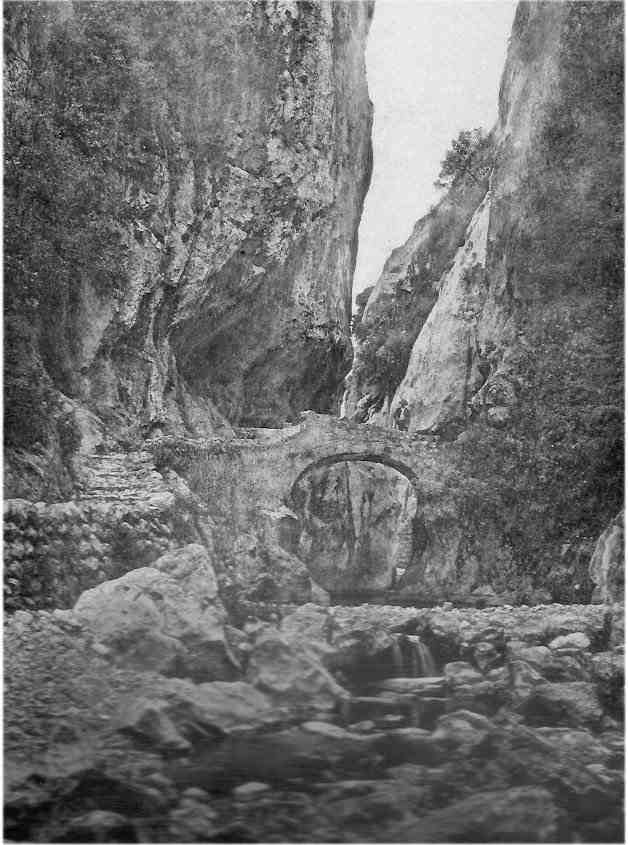
El Gorg Blau (Escorca, Majorca) as it looked before 1904. Source: http://commons.wikimedia.org/wiki/File:Gorg_blau.jpg
This place in Majorca, which was very popular because of the attention paid to it by painters and writers, disappeared in 1971 as a result of the construction of the reservoir of the same name. The stream that passed through it, however, still flows between rock faces of up to three hundred metres high.
The stained glass triptych
The Blue Pool is the title of the stained glass triptych that concludes the first part of the visit to the museum’s new Modern Art presentation. The work, designed in 1911 by the landscape painter Joaquim Mir and produced by the Rigalt i Granell stained glass workshop, the most prestigious in Modernista Barcelona, catches the visitor’s eye for its beauty and monumentality.
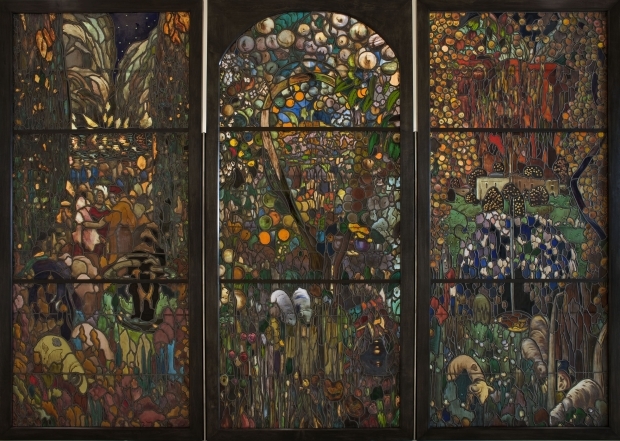
Joaquim Mir. The Blue Pool, around 1911. Museu Nacional d’Art de Catalunya
The three panels that make up this large stained glass triptych feature an exuberant and paradisiacal landscape, very colourful and with a wealth of detail. In one of the side panels, a couple of shepherds are conversing beside the flock. In the background of the scene, the brightness of a starry night illuminates a very narrow gorge that is reflected in the water of a lake. It is, almost certainly, an idealized image of the Gorg Blau beauty spot, which Joaquim Mir would have seen during his crucial sojourn in Majorca, from 1900 to 1904.
The stained glass triptych designed by Mir is outstanding for various reasons. Firstly, it is one of the very few forays that the painter made in the field of applied arts and interior decoration. The stained glass triptych was part of the decoration that Mir did for his uncle Avel·lí Trinxet’s new house in the Eixample district, a Modernista detached house built by Josep Puig i Cadafalch between 1902 and 1904, no longer standing.

Back view of Casa Trinxet with the garden. Source: https://ca.wikipedia.org/wiki/Casa_Trinxet#/media/File:Trinxet_21.jpg
Technique and style
The Blue Pool is also very interesting from the technical and stylistic points of view. The artist designed it using the free, colourful and bold style that characterizes his paintings of the time, when he lived in the countryside around Tarragona (1905-1913). The landscape paintings from those years are in fact considered the best testimony to the originality of the art of Joaquim Mir, the finest painter of the second generation of Modernisme, together with Isidre Nonell.
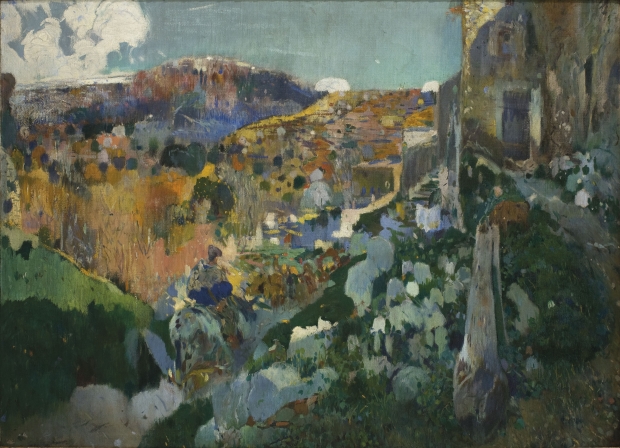
Joaquim Mir. The Jewel, around 1910. Museu Nacional d’Art de Catalunya
During the time he stayed in the villages around Reus, Mir represented what he saw through juxtaposed splashes of bright colours, creating a very free and personal interpretation of the place that inspired him, very often verging on abstraction. This technique was highly relevant for doing a stained glass mosaic, the form that had become fashionable in Modernista Barcelona, because it was easy to match a glass tile to each splash of colour.
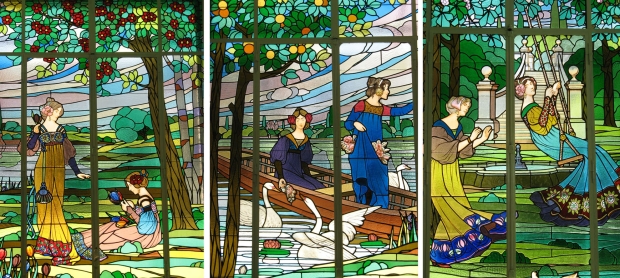
Les dames de Cerdanyola, a work by Ludwig Dietrich, dated to around 1910, is one of the finest examples of a stained glass mosaic conserved in Catalonia. Museu d’Art de Cerdanyola. Photo: Kippelboy https://commons.wikimedia.org/wiki/File:Cerdanyola-Les-dames-de-Cerdanyola.jpg
When planning The Blue Pool, it was Joaquim Mir’s wish to make the job of the master stained glass makers even easier, and in the preparatory sketch he outlined the famous splashes with a dark line, thus clearly indicating the edges of each piece of glass and the points where it was joined to the lead came. The craftsmen of Rigalt i Granell must undoubtedly have thanked him for making it so easy for them.
The Majorcan landscape
Besides the technical and artistic details, however, one of the aspects that almost certainly make the stained glass triptych The Blue Pool special is its thematic uniqueness. As far as we know, it is the only work in which Mir returns to the themes and landscapes of Majorca after his sudden departure from the island as a result of an accident that nearly cost him his life.
Joaquim Mir had gone to Majorca at the very beginning of the 20th century in search of new landscapes from which to gain inspiration. He arrived knowing that he would be able to do nothing else but paint, thanks to the agreement signed with Avel·lí Trinxet. According to this pact, hitherto unheard of in Catalan art, the artist would receive a fixed monthly payment in return for delivering the finished work to his uncle, who would then be in charge of selling it. Mir first lived near the coast, in the company of Santiago Rusiñol and his family, but he soon discovered the pictorial potential of the Tramuntana mountain range. Obsessed with finding unspoilt landscapes that would enable him to develop a genuine style of his own, he cut himself off from the world and his surroundings and succumbed to a creative fever that was to produce wonderful results.
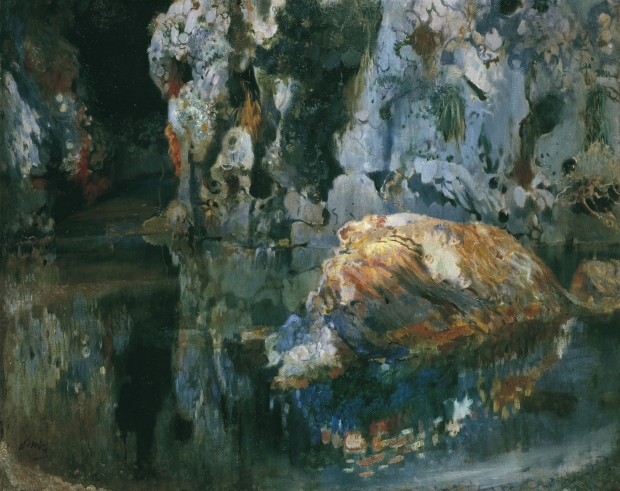
Joaquim Mir. The Rock in the Pond, around 1903. Museu Nacional d’Art de Catalunya
When painting the mountains of Majorca, Mir no longer restricted himself to reproducing the landscapes that he saw; rather, in his works he captured his most personal vision of the surroundings, its interior landscape, using an absolutely original pictorial language. These creations would be the basis of the even freer and more natural style of his later period in Reus.
The creative vivacity of Majorca, however, eventually cost the artist dear. On 24th April 1904, while he was painting on a crag next to the Torrent de Pareis, Mir fell into the bed of the gorge in circumstances that have never been made clear. As a consequence of the accident he suffered a serious nervous breakdown that resulted in him spending two years in the Pere Mata Institute of Psychiatry in Reus.
If the experience in Majorca had ended so traumatically, why did Mir decide to use an emblematic beauty spot on the island for the stained glass triptych The Blue Pool? The answer once again seems to lie with his uncle Avel·lí. Between 1903 and 1904, the painter had begun decorating the interior of the Trinxet family house, embellishing the walls of the main dining room with brightly coloured panels inspired by the landscapes of Majorca.
Due to the accident the decorative project was halted, and Mir would not resume the work until the late 1910s, when he must have given in to the insistent demands of his uncle and patron. He decorated the small dining room with panels inspired by the landscape of Tarragona and designed six pieces of stained glass, four for the windows in the chapel and two, the most ambitious ones, The Blue Pool and La Vita, for the main rooms.
The Blue Pool was probably going to be set near the main dining room, and as that room was decorated with island landscapes, they wanted to maintain a thematic unity by choosing a theme from Majorca for the stained glass. Whatever the case, it is significant that Mir should have depicted a place that as far as we know he never painted while he was living on the island. By doing this, was he perhaps settling an outstanding debt with the original Gorg Blau?
Paradoxically, despite the importance of the stained glass triptych, and although it was a personal commission, The Blue Pool never occupied the place that had been created for it in Casa Trinxet. In 1911, shortly after the Rigalt i Granell workshop had finished the triptych, Uncle Avel·lí decided to take it to the 6th Barcelona International Art Exhibition. The piece came to the attention of the municipal authorities and, when presented with an offer of purchase, Mir’s relative and patron seems to have had few problems in parting with it. In this way, the stained glass triptych The Blue Pool became one of the first works by Joaquim Mir to become part of the city of Barcelona’s public art collections.
Amics del Museu Nacional d'Art de Catalunya







